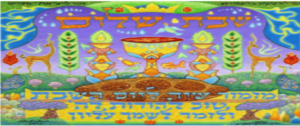By Rabbi Moshe Goodman, Kollel Ohr Shlomo, Hebron
בס”ד
לשכנו תדרשו
Discover the Holy Presence in Our Holy Land
The Holy Shabbat

“What, also this parsha mentions the keeping of Shabbat?” some may say… In fact, we may say that the book of Shmot as a whole carries the theme of Shabbat more than any other of the books of the Torah: in the context of the Mann(a), in the Ten Commandments, in the laws of Mishpatim, in parshat Ki Tisa – both in the beginning and end of the parsha, and in parshat Vayakhel. Also, the long description of the building of the Mishkan at the end of this book conveys direct and deep implications on the laws of Shabbat, as our Oral Tradition teaches that the 39 labors prohibited on Shabbat are learned from the labors used to construct the Mishkan. One explanation for this can be found explicitly in the Torah in the Ten Commandments of parshat Vaetchanan: “you shall keep the Shabbat… so that you remember that you were a slave in Egypt and Hashem redeemed you.” Simply put, Shabbat is the day that emancipates us from the labors of the week, also reminding us of our national emancipation from Egypt by Hashem. Therefore, it is not surprising that the book of Shmot, known to be the Book of the Exodus, Redemption, and Emancipation, puts particular emphasis on the Emancipating Shabbat.
In Nachshon’s painting here we see a strong dualism throughout the whole painting, reflecting the famous custom of lighting (at least) two candles, one parallel to Zachor (“Remember”) et Yom Hashabbat, mentioned in the Ten Commandments of parshat Yitro, and the second paralleling Shamor (“Keep”) et Yom Hashbbat, mentioned in the Ten Commandments of parshat Vaetchanan. The Talmud also recalls an episode when an individual took two hadasim (myrtles) in honor of Shabbat for just this reason. Indeed, in this painting, we see dual candles and dual hadasim, but not only that… I have noticed seven types of dualisms in this painting: 1. The letter shin [usually connoting the Divine Name/Providence in Nachshon’s paintings (as these are used both in tefillin and mezuzot)] 2. Candles 3. Hadasim 4. Gazelles 5. Peacocks 6. Trees 7. Pomegranates. It seems that the number seven here also comes to convey the dominance of the number seven with respect to Shabbat, the Seventh Day. There are also seven blue “celestial leaves” where the quail rests on the seventh leaf, which may represent the “feasting on quail” found in the zemirot of Shabbat, the Seventh Day.
One meaning we can internalize about the “dualism of Shabbat” discussed here is through the identification of Shabbat as the “sign of the covenant between Hashem and Israel.” This covenant/”marriage” is hinted at by the Song of Songs, the “Dual Song Between Husband and Wife,” customarily recited at the eve of Shabbat. Thus, it is obvious why this dualism is such a strong theme of Shabbat. This year we are privileged to celebrate the Shabbat of the Land, the Shemita year, which also carries a strong dualism between Israel and the Holy Land, described by Isaiah (62, 2) along with other sources as husband and wife, between whom the Holy Presence rests. May we merit the enlightenment of both of these types of Shabatot, especially through the light of Hebron, which joins [“hibur”] our People to our Holy Land and to the Holy Presence in such a deep way.



